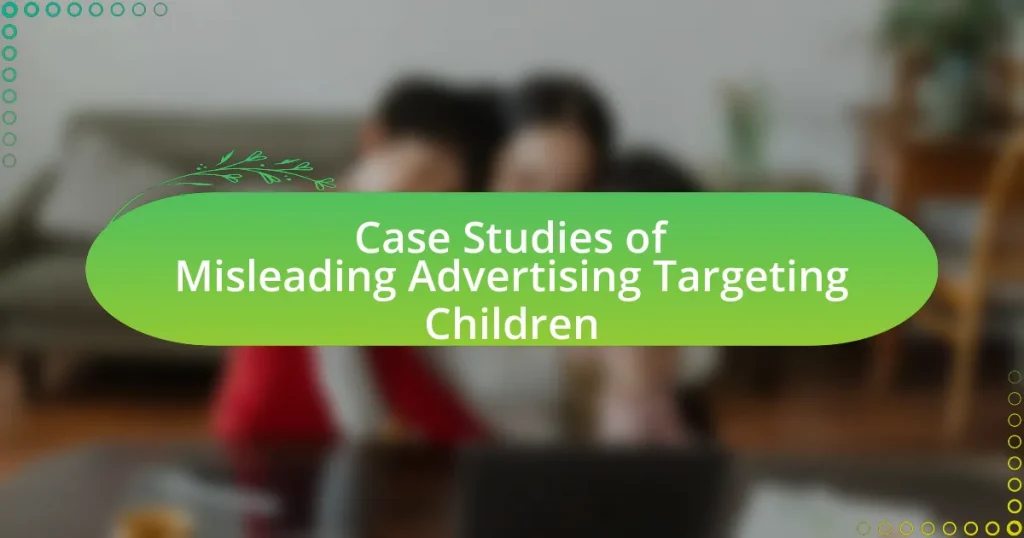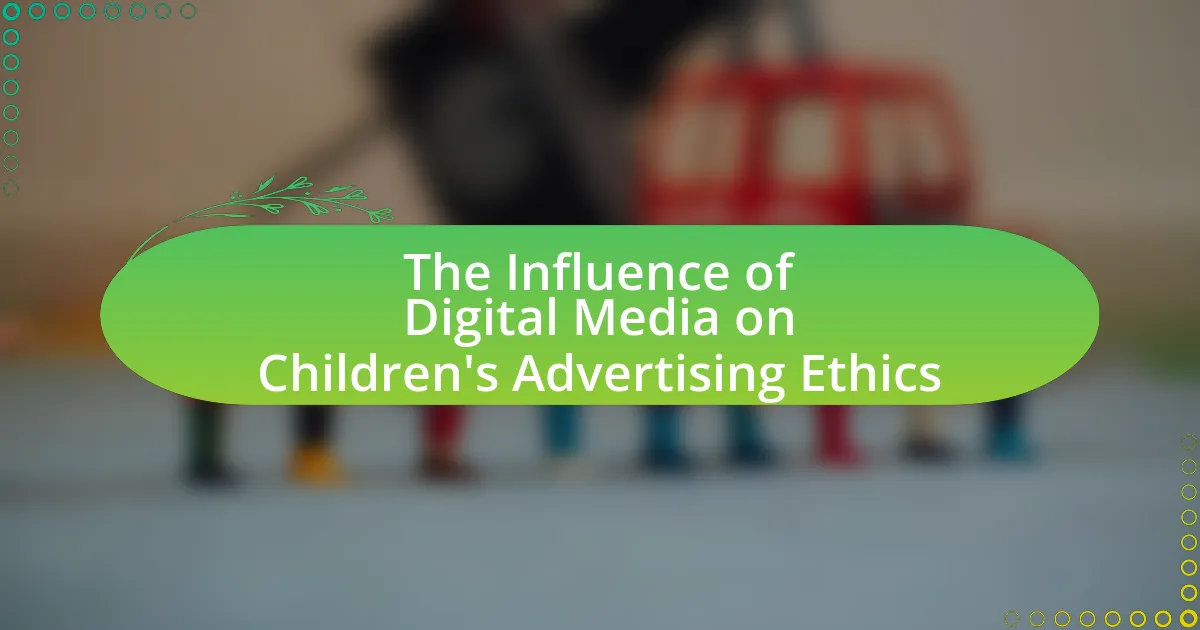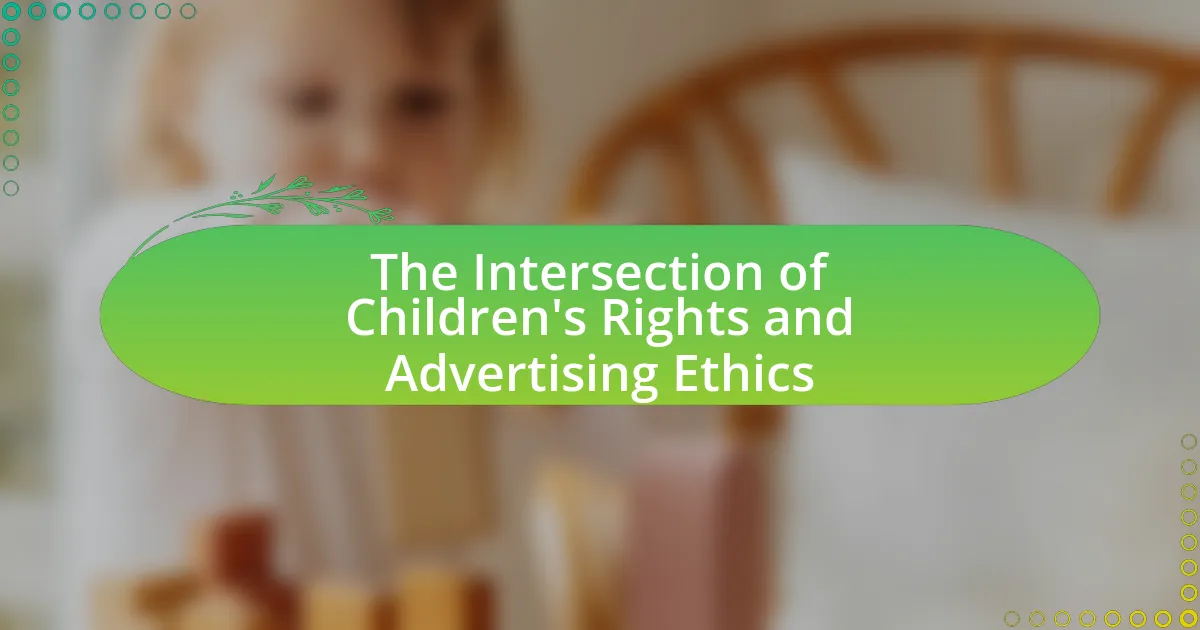The article examines case studies of misleading advertising targeting children, highlighting specific instances where companies employed deceptive marketing practices. Notable examples include the Cap’n Crunch cereal campaign and McDonald’s Happy Meals, both criticized for promoting unhealthy products through appealing visuals and characters. The article discusses the psychological effects of such advertising on children’s behavior, the tactics used to mislead them, and the legal frameworks in place to protect young audiences. Additionally, it explores the role of parents and educators in combating misleading advertising through media literacy and critical thinking education.

What are Case Studies of Misleading Advertising Targeting Children?
Case studies of misleading advertising targeting children include instances where companies have used deceptive practices to promote products. One notable example is the 2010 case involving the cereal brand Cap’n Crunch, which was criticized for using cartoon characters and colorful packaging to attract children while downplaying the high sugar content of the product. Research by the American Academy of Pediatrics highlights that such marketing strategies can lead to unhealthy dietary choices among children, as they often do not understand the implications of the advertisements. Another example is the 2013 controversy surrounding McDonald’s Happy Meals, where the company faced backlash for promoting toys that incentivized unhealthy eating habits among children. The Federal Trade Commission has documented these practices, emphasizing the need for stricter regulations to protect young audiences from misleading advertising.
Why is misleading advertising a concern for children?
Misleading advertising is a concern for children because it can distort their understanding of products and influence their behavior in harmful ways. Children are particularly vulnerable to deceptive marketing tactics due to their cognitive development stage, which makes it difficult for them to differentiate between reality and advertising. Research from the American Psychological Association indicates that children under the age of eight are unable to critically evaluate advertising messages, leading them to accept claims at face value. This can result in unhealthy consumption patterns, as children may be persuaded to desire products that do not meet their needs or are not beneficial for their health.
What psychological effects does misleading advertising have on children?
Misleading advertising has significant psychological effects on children, including the development of unrealistic expectations and materialistic attitudes. Children exposed to deceptive marketing may believe that products will enhance their social status or happiness, leading to disappointment when reality does not meet these inflated claims. Research indicates that children aged 8 to 12 are particularly susceptible to such influences, as they often lack the cognitive skills to critically evaluate advertising messages. A study published in the Journal of Consumer Research by authors Anna S. McAlister and John A. B. McAlister found that children who viewed misleading advertisements were more likely to exhibit increased desire for the advertised products, demonstrating how these ads can shape their preferences and behaviors.
How does misleading advertising influence children’s purchasing behavior?
Misleading advertising significantly influences children’s purchasing behavior by creating false perceptions about products. Children, who are often unable to critically evaluate advertising messages, may develop a desire for products based on exaggerated claims or misleading representations. For instance, a study published in the Journal of Consumer Research found that children exposed to advertisements featuring animated characters were more likely to request those products, regardless of their actual quality or suitability. This demonstrates that misleading advertising can manipulate children’s preferences and increase their likelihood of making purchases based on deceptive information.
What are the common tactics used in misleading advertising aimed at children?
Common tactics used in misleading advertising aimed at children include the use of cartoon characters, catchy jingles, and the promotion of unhealthy food as fun or desirable. Advertisers often employ beloved characters from popular media to create an emotional connection, making products more appealing. Research indicates that children are more likely to request products endorsed by characters they recognize, as shown in a study published in the Journal of Consumer Research, which found that children aged 4 to 6 were significantly influenced by character endorsements. Additionally, advertisements frequently utilize bright colors and animations to capture attention, while presenting misleading health claims that suggest products are nutritious or beneficial, despite high sugar or fat content. This tactic exploits children’s limited ability to critically evaluate advertising messages, leading to misconceptions about the products being marketed.
How do visuals and characters play a role in misleading advertisements?
Visuals and characters significantly contribute to misleading advertisements by creating emotional connections and appealing to children’s imaginations. Advertisements often use vibrant colors, animated characters, and relatable figures to capture attention and foster a sense of trust or excitement. For instance, studies show that children are more likely to believe claims made by cartoon characters than by adults, as they perceive these characters as friendly and trustworthy. This phenomenon is supported by research from the American Psychological Association, which indicates that children aged 8 to 12 are particularly susceptible to persuasive techniques that utilize engaging visuals and familiar characters, leading to misconceptions about the product’s benefits or suitability.
What role does emotional appeal have in targeting children?
Emotional appeal plays a crucial role in targeting children by leveraging their developing emotional intelligence and susceptibility to feelings. Advertisers often use relatable characters, engaging narratives, and vibrant visuals to evoke emotions such as happiness, excitement, or nostalgia, which can significantly influence children’s preferences and purchasing decisions. Research indicates that children are more likely to remember and be persuaded by advertisements that elicit strong emotional responses, as their cognitive abilities are still maturing, making them less critical of the messages presented. For instance, a study published in the Journal of Advertising Research found that emotionally charged advertisements can increase brand recall among children by up to 50%, demonstrating the effectiveness of emotional appeal in this demographic.
What legal frameworks exist to protect children from misleading advertising?
Legal frameworks that protect children from misleading advertising include the Children’s Online Privacy Protection Act (COPPA) in the United States, which restricts the collection of personal information from children under 13 and mandates clear disclosures about advertising practices. Additionally, the Federal Trade Commission (FTC) enforces regulations against deceptive advertising practices, ensuring that advertisements directed at children are not misleading. In the European Union, the Audiovisual Media Services Directive (AVMSD) sets strict rules on advertising to children, prohibiting misleading content and ensuring that advertisements are clearly distinguishable from programming. These frameworks collectively aim to safeguard children from exploitation and misinformation in advertising.
How do different countries regulate advertising to children?
Different countries regulate advertising to children through a variety of laws and guidelines aimed at protecting young audiences from misleading or harmful content. For instance, in Sweden and Norway, there are strict bans on all advertising directed at children under the age of 12, which prohibits any commercial messages during children’s programming. In contrast, the United States employs a self-regulatory approach, where organizations like the Children’s Advertising Review Unit (CARU) set guidelines that advertisers are encouraged to follow, focusing on truthfulness and appropriateness. The European Union has established the Audiovisual Media Services Directive, which mandates that member states implement measures to protect minors from harmful advertising, including restrictions on the timing and content of ads. These regulations reflect a global recognition of the need to safeguard children from exploitative marketing practices.
What are the consequences for companies that engage in misleading advertising targeting children?
Companies that engage in misleading advertising targeting children face significant legal and financial consequences. Regulatory bodies, such as the Federal Trade Commission (FTC) in the United States, can impose fines and sanctions for violations of advertising standards, particularly those protecting minors. For instance, in 2019, the FTC settled with a major toy company for $3 million due to deceptive marketing practices aimed at children, highlighting the financial repercussions of such actions. Additionally, companies may suffer reputational damage, leading to loss of consumer trust and decreased sales. Research indicates that brands perceived as unethical can experience a 20% drop in customer loyalty, further emphasizing the long-term impact of misleading advertising on a company’s market position.

What are some notable case studies of misleading advertising targeting children?
Notable case studies of misleading advertising targeting children include the 2006 “McDonald’s Happy Meal” campaign, which was criticized for promoting unhealthy eating habits among children by associating toys with fast food. The campaign led to a significant backlash from health advocates, resulting in McDonald’s pledging to improve the nutritional quality of its meals. Another example is the 2010 “Kraft’s Lunchables” advertisements, which were found to mislead children by portraying the product as a healthy meal option despite its high sodium and fat content. These cases highlight the ongoing concern regarding the ethical implications of marketing strategies aimed at young audiences.
What specific examples highlight the impact of misleading advertising on children?
Misleading advertising significantly impacts children, as evidenced by several specific examples. One notable case is the 2013 study published in the journal “Pediatrics,” which found that children exposed to food advertisements were more likely to choose unhealthy snacks over healthier options. This study highlighted that children aged 2 to 11 who viewed ads for sugary cereals were influenced to prefer those products, leading to poor dietary choices. Another example is the 2015 research conducted by the University of California, which revealed that children who watched commercials for toys were more likely to nag their parents for those items, demonstrating how advertising can manipulate children’s desires and influence parental purchasing decisions. These examples illustrate the profound effects of misleading advertising on children’s preferences and behaviors.
How did the “Sugary Cereal” advertising campaign mislead children?
The “Sugary Cereal” advertising campaign misled children by promoting cereals as healthy breakfast options while downplaying their high sugar content. Advertisements often featured colorful characters, toys, and fun themes that appealed to children’s emotions, creating a perception that these cereals were not only enjoyable but also nutritious. Research from the American Journal of Clinical Nutrition indicates that many cereals marketed to children contain over 30% of their calories from sugar, yet the advertising often emphasizes vitamins and minerals, obscuring the unhealthy aspects. This strategy exploits children’s limited ability to critically evaluate marketing messages, leading them to associate sugary cereals with positive experiences and neglect their nutritional drawbacks.
What lessons were learned from the “Fast Food” advertising case study?
The “Fast Food” advertising case study revealed that misleading advertising significantly influences children’s food choices and preferences. Research indicates that children are particularly susceptible to marketing tactics that promote unhealthy food options, leading to increased consumption of fast food and associated health risks. For instance, a study published in the journal “Pediatrics” found that exposure to fast food advertisements correlates with higher rates of obesity among children. This highlights the need for stricter regulations on advertising aimed at young audiences to protect their health and well-being.
What were the outcomes of these case studies for the companies involved?
The outcomes of the case studies on misleading advertising targeting children resulted in significant reputational damage and financial penalties for the companies involved. For instance, a prominent fast-food chain faced a lawsuit that led to a settlement requiring them to change their advertising practices, which highlighted the legal repercussions of misleading marketing. Additionally, a major toy manufacturer experienced a decline in consumer trust, prompting a reevaluation of their marketing strategies to ensure compliance with ethical standards. These outcomes underscore the importance of responsible advertising practices in maintaining brand integrity and consumer loyalty.
How did public backlash affect the advertising strategies of these companies?
Public backlash significantly influenced the advertising strategies of companies involved in misleading advertising targeting children. In response to negative public sentiment and increased scrutiny from advocacy groups, many companies revised their marketing approaches to prioritize transparency and ethical standards. For instance, after facing criticism for promoting unhealthy food products to children, several major food brands implemented stricter guidelines on advertising content, focusing on healthier options and reducing the use of cartoon characters in their campaigns. This shift was evident in the 2019 initiative by the Children’s Food and Beverage Advertising Initiative, where participating companies committed to limiting advertising to children under 12 for products that do not meet specific nutritional criteria. Such changes demonstrate how public backlash can lead to more responsible advertising practices aimed at protecting vulnerable audiences.
What changes were implemented in response to these case studies?
In response to the case studies of misleading advertising targeting children, regulatory bodies implemented stricter guidelines and regulations on advertising practices aimed at young audiences. For instance, the Federal Trade Commission (FTC) revised its guidelines to prohibit deceptive marketing tactics that exploit children’s naivety, emphasizing transparency and truthfulness in advertisements. Additionally, several companies voluntarily adopted self-regulatory measures, such as limiting the use of certain persuasive techniques and ensuring that advertisements are clearly distinguishable from programming. These changes were driven by growing concerns over the impact of misleading advertising on children’s health and well-being, as highlighted in various studies demonstrating the negative effects of such marketing practices.

How can parents and educators combat misleading advertising targeting children?
Parents and educators can combat misleading advertising targeting children by promoting media literacy and critical thinking skills. By teaching children to analyze and question advertisements, they become more aware of marketing tactics and less susceptible to manipulation. Research indicates that media literacy programs can significantly improve children’s ability to discern advertising intent and recognize misleading claims. For instance, a study published in the Journal of Advertising Research found that children who participated in media literacy education were better at identifying persuasive techniques used in advertisements. Additionally, parents can engage in discussions about advertising during media consumption, reinforcing the skills learned in educational settings.
What strategies can parents use to educate children about advertising?
Parents can educate children about advertising by engaging them in discussions about the purpose and techniques of advertisements. This can include explaining how ads are designed to persuade consumers, often using emotional appeals or celebrity endorsements. Research indicates that children as young as 8 years old can understand the persuasive intent of advertising when it is explicitly discussed (Luna, 2019, Journal of Consumer Research). Parents can also encourage critical thinking by analyzing advertisements together, asking questions about the message, target audience, and the truthfulness of claims. Additionally, using real-life examples of misleading advertisements can help children recognize deceptive practices. By fostering media literacy, parents equip children with the skills to navigate advertising effectively.
How can parents encourage critical thinking regarding advertisements?
Parents can encourage critical thinking regarding advertisements by engaging children in discussions about the intent and content of ads. By asking questions such as “What do you think this advertisement is trying to sell?” or “How does this ad make you feel?” parents can help children analyze the persuasive techniques used in advertising. Research indicates that children who are taught to critically evaluate advertisements are less likely to be influenced by misleading marketing tactics. For instance, a study published in the Journal of Consumer Research found that children exposed to critical thinking exercises about ads showed improved skepticism towards promotional messages. This approach not only fosters analytical skills but also empowers children to make informed decisions about the products they encounter.
What resources are available for parents to help children understand advertising?
Parents can utilize various resources to help children understand advertising, including educational websites, books, and workshops. Websites like Common Sense Media provide guides on media literacy, specifically tailored for children, which explain how advertising works and its impact. Books such as “The Advertising Effect: How to Change Behaviour” by Adam Ferrier offer insights into advertising strategies and can be used as discussion starters. Additionally, local community centers often host workshops focused on media literacy, where parents and children can learn together about recognizing and critically analyzing advertisements. These resources collectively empower parents to educate their children about the nuances of advertising and its potential misleading aspects.
What role do schools play in addressing misleading advertising?
Schools play a crucial role in addressing misleading advertising by educating students about media literacy and critical thinking skills. Through curricula that include lessons on identifying deceptive marketing practices, schools empower children to analyze advertisements critically. Research indicates that media literacy programs can significantly enhance students’ ability to discern misleading information, with studies showing that students exposed to such education demonstrate improved skills in evaluating advertising claims. By fostering an environment where students can discuss and question advertising tactics, schools contribute to a more informed youth capable of making better consumer choices.
How can educators incorporate media literacy into their curriculum?
Educators can incorporate media literacy into their curriculum by integrating critical analysis of media content, particularly focusing on advertising aimed at children. This can be achieved through lessons that examine the techniques used in misleading advertisements, such as emotional appeals and deceptive visuals. Research indicates that children are particularly vulnerable to such tactics, making it essential for educators to teach students how to identify and question these strategies. For instance, a study by the American Psychological Association highlights that children under the age of eight often cannot distinguish between commercials and regular programming, underscoring the need for media literacy education. By using case studies of misleading advertising, educators can facilitate discussions and activities that empower students to critically evaluate media messages, fostering informed consumers who can navigate the complexities of advertising.
What programs exist to support schools in teaching about advertising ethics?
Programs that support schools in teaching about advertising ethics include the “Ad Council’s Ad Literacy Program,” which provides resources for educators to teach students about advertising’s impact and ethical considerations. Additionally, the “National Association of Broadcasters Education Foundation” offers materials that focus on media literacy, including advertising ethics. These programs are designed to enhance students’ understanding of advertising practices and encourage critical thinking about the messages they encounter.
What best practices should parents and educators follow to protect children?
Parents and educators should implement clear communication and education about media literacy to protect children from misleading advertising. By teaching children to critically analyze advertisements, they can better understand the intent behind marketing messages. Research indicates that children are particularly vulnerable to deceptive advertising tactics, as they often lack the cognitive skills to discern between entertainment and marketing (American Psychological Association, 2013). Additionally, parents and educators should establish guidelines for screen time and monitor the content children are exposed to, ensuring that it aligns with age-appropriate standards. This proactive approach helps create a safer environment for children, reducing their susceptibility to misleading advertising.






